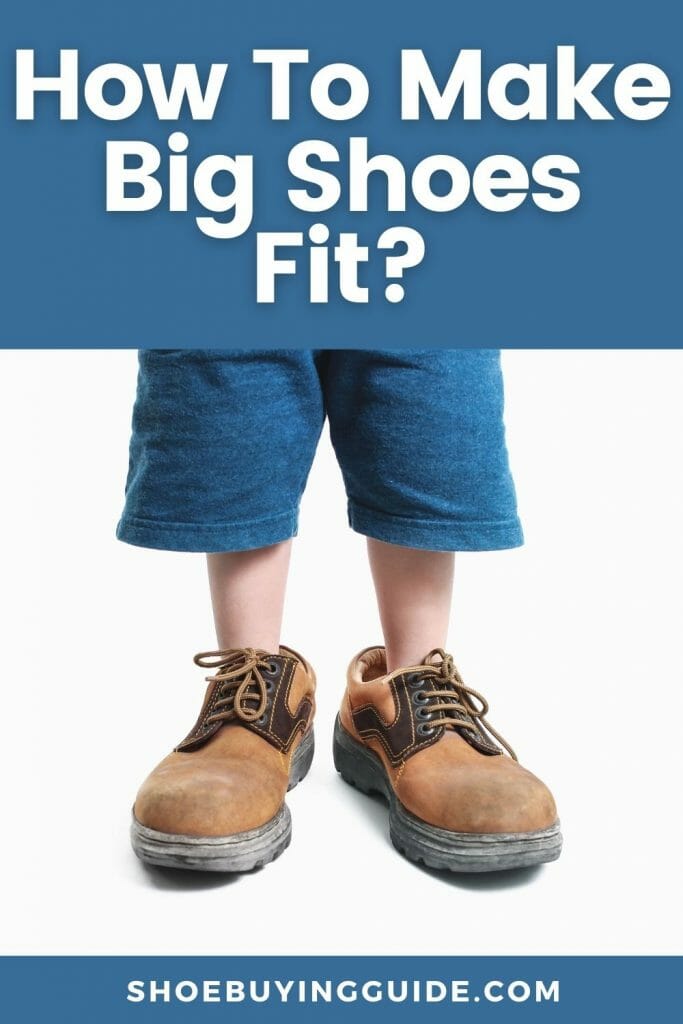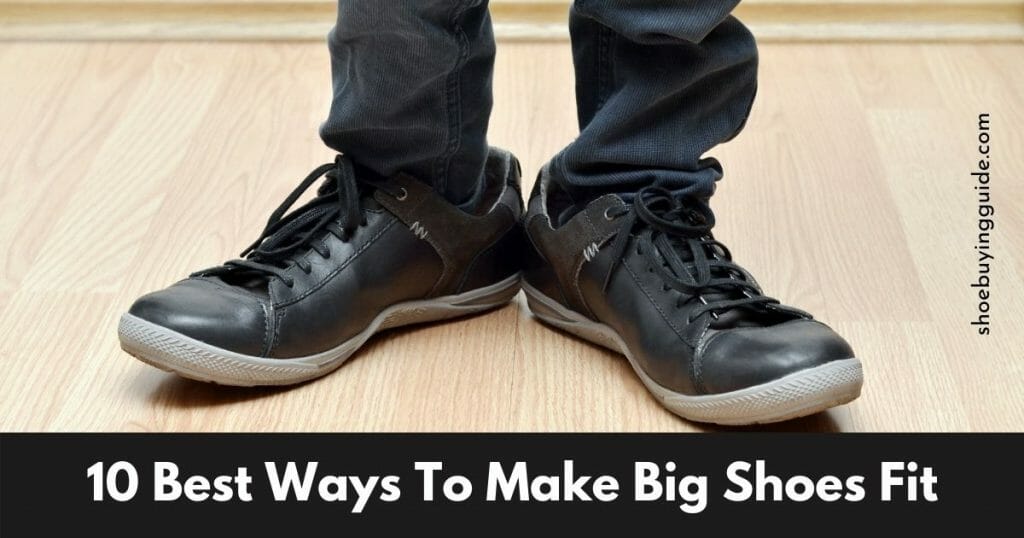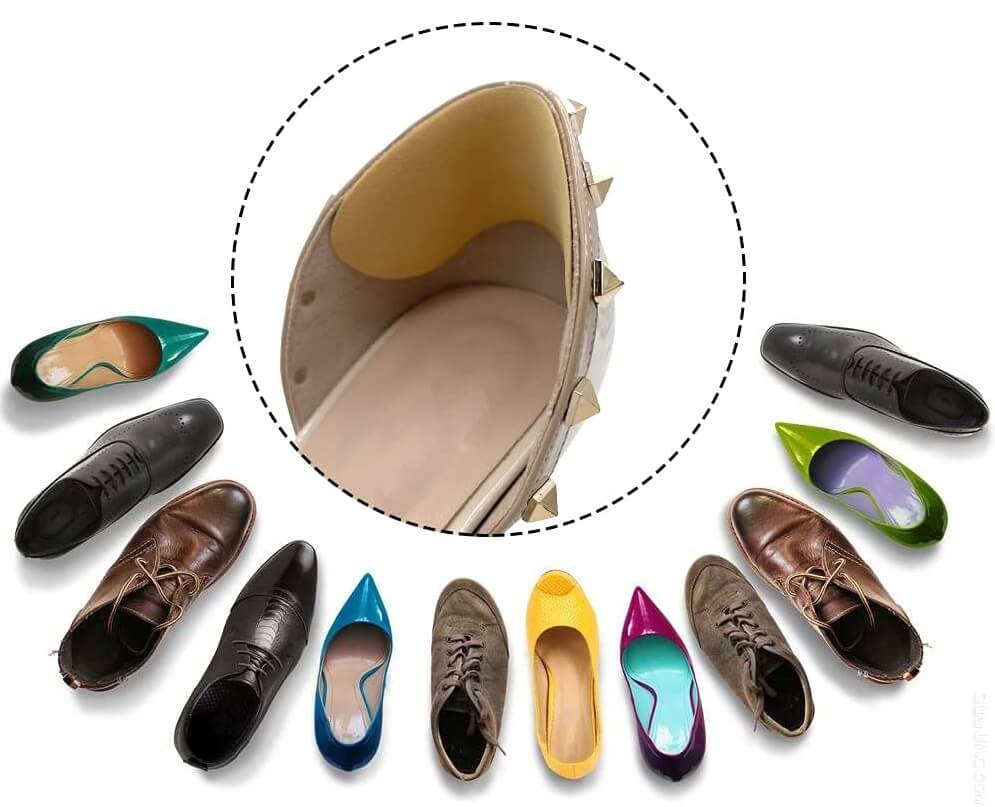We’ve all been in the situation when we got a shoe online, and when it arrived, it didn’t fit quite right. Oversized shoes could be irritating and increase your chances of falling or slipping if you lose your balance or put traction on the ground. They can also appear strange if they are excessively big. They may, for example, flap off the heel of your foot in the back while you walk or even slip off at the slightest misstep.
But It’s not always easy to identify if a shoe fits poorly until you take it home and try it on for the first time. Unfortunately, if you’re already dressed to wear it, this can put you in a bind. If you don’t have the time or want to change your clothes. There are a few options for getting those big shoes to fit properly. Continue reading to discover more about these tricks and determine which one is right for you.

Should Your Toes Touch The End Of Shoes?
No, your toes should never touch the end of your shoe’s toe box. If they do, they are most likely too small. The simplest way to examine the fit of your shoes is to lay your thumb on the toe of the shoe between your big toe and the tip of the shoe. So, in this section, we’ll find several effective methods to solve this problem of large shoes that don’t fit.
10 Best Ways To Make Big Shoes Fit

If you are wondering how to make big shoes fit comfortably, so you can enjoy your new footwear, here are some best tips. By following this guide, you will not only be able to make these shoes fit or more comfortable, but you will also be able to walk more safely in them.
- Use Insoles
- Add An Insert
- Buy Shoe Fillers
- Apply Heel Strips
- Use A Little Water
- Stuff The Toe Box
- Visit A Shoe Care Professional (Aka “Cobbler”)
- Use An Elastic Band To Make Tight
- Wear Multiple Pairs Of Socks
1. Use Insoles

Insoles are pieces of cloth that go inside your shoes or boots to provide extra comfort, warmth, and a better fit. Insoles, often known as ‘foot beds’ or ‘inner soles,’ serve the primary goal of making shoes more comfortable to wear. While insoles do not shrink a shoe, they do fill the space between your feet and the inside of the shoe.
Insoles can also be removed and cleaned, which helps to keep shoes fresh. Furthermore, when shoes are unusually big, they can be worn with toe inserts to provide additional support.
2. Add An Insert
A few shoe inserts on the market are designed to make big shoes fit smaller, but you must pick the proper insert for the right shoes. You can begin with a complete shoe insole. This is typically gel or foam material inserted into the bottom of your shoes. Insoles are designed to provide support and comfort and can sometimes aid with posture, but they also take up space in too-big shoes.
This could be a wonderful option for you because you’ll be able to test on different insoles to see which one works best for your shoes.
Some insoles may fit uncomfortably and take up too much space, causing the shoe to become too tight, but you can try other inserts that do not cover the entire shoe length.
Arch supports are also an excellent option to free up some room in your shoes. These pads provide support and friction, and because they are smaller, they are less likely to be visible in certain shoes, making them ideal for heels that are just a tad too big.
Heel cushions are the final component we recommend trying. These inserts, which are often made of gel or foam, take up any additional space that may exist between the back of your foot and the shoes.
3. Buy Shoe Fillers
Buying shoe fillers is another solution that can save space in big shoes. Shoe fillers are typically silicone, polyurethane, and elastic and are placed in the toe box to remove a few centimeters of space. You can use shoe fillers alone or couple them with heel liners to double their effectiveness. They’re reasonably priced, ranging from $8 to $15 online or in most shoe department stores.
4. Apply Heel Strips

Source: amazon.com
Heel strips function similarly to shoe fillers, but they are positioned at the end of the shoe and fastened to the backside of the heel. These strips have a sticky adhesive backing and come in various sizes.
The great thing about heel strips is that you can use them anyplace in the shoe to decrease space or add soft cushioning. They have widely applied in high heels as well as men’s and women’s formal shoes.
5. Use A Little Water
This technique has been used for around 30 or 40 years and does not appear to disappear anytime soon. If you don’t want to spend money on improving the fit of your shoes, you can wet them with water and air dry them to generate a shrinkage effect.
It’s necessary to keep in mind that this procedure may not suit all shoe types. Because water can permanently damage leather or suede shoes. To begin using this process, take a spray bottle and saturate the shoes. If the shoes are composed of rubber and leather, you may be able to soak them in a sink of water rapidly.
Allow the shoes to air dry outside in the sun or a dry location in your home after being wet. To dry the shoes, you can also use a hairdryer (set to “low”). Keep the hairdryer at least 6 to 8 inches away from the shoe to avoid scorching the surface.
After your shoes have dried, try them on to make sure they fit properly. If they are still too large, repeat the process one or two times.
It is recommended that you do not repeat this more than a couple of times. To avoid damaging leather or suede shoes, you should apply a conditioner after shrinking them. This may be obtained for less than $20 online or in any department, shoe, or pharmacy store.
6. Stuff The Toe Box
Simply stuffing the shoe’s toe box is an easy and low-cost solution to get your large shoe to fit. The “toebox” section of a shoe refers to the area surrounding the toes.
One alternative is to cut a pair of socks and shove them in the shoe’s toe area. If you don’t have any old socks lying around, you can substitute a piece of couch cushion or a pillow.
Basically, any soft or packed padding material will suffice for this approach. The idea is to choose a soft material that your toes do not feel sore throughout the day. A handful of cotton balls, chopped-up towels, or soft tissue paper can also be used. Except for open-toe sandals, this approach applies to every shoe.
7. Visit A Shoe Care Professional (Aka “Cobbler”)
If you don’t want to risk damaging the shoes, you may always take them to a professional–this may be a preferable alternative if they are costly.
Cobblers can shrink your shoes for a better fit using various techniques. Though cobblers aren’t as popular as they were a century ago, they are nonetheless treasured by anyone who has ever had problems with a shoe that they didn’t want to throw away. Keep in mind that their services can be pricey, so you’ll want to make sure the shoe is worth it.
8. Use An Elastic Band To Make Tight
Using an elastic band on the shoe is a technique you may not have considered. This solution works best if you have some embroidery or sewing skills. To do this hack, sew elastic bands to the inside of your shoes to constrict them. This will need a certain level of knowledge and a great deal of attention to detail.
A needle, thread, and an elastic band at least 12 inches long are required. Use safety pins to keep it in place as you begin to stitch the band onto one side of the shoe. Keep the elastic tightly as you stitch the band into the shoe, and then remove it when finished.
10. Wear Multiple Pairs Of Socks

This last solution may appear straightforward, but it has major downsides. Simply putting on a thicker pair of socks, or bulking up and layering your socks the same way you layer your sweaters in the fall, is a simple solution. The more cushioning there is, the tighter the shoe will fit your foot.
This technique works well with boots and athletic shoes, albeit wearing many pairs of socks while working out does not sound desirable (in fact, it sounds sweaty and gross). Therefore, we would advise against wearing heavier socks if you have naturally sweaty feet.

